 How much trust fund allowance was wasted on this stupid slogan?
How much trust fund allowance was wasted on this stupid slogan?
Category: South St. Louis
by Michael R. Allen
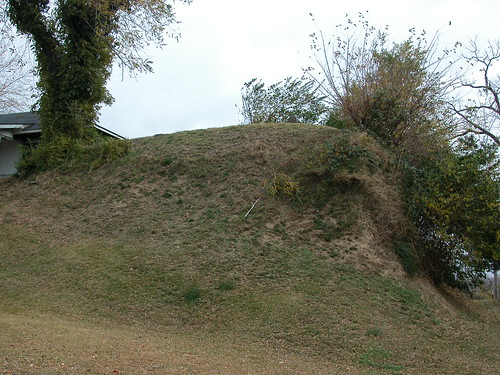 According to the office of U.S. Representative Russ Carnahan (D-3rd), the Osage Nation will purchase the property that includes Sugar Loaf Mound near I-55 and Broadway in south St. Louis. The Osage Nation plan to use the site for interpretive and educational purposes. Sugarloaf Mound is the last remaining mound in a city once nicknamed “Mound City.”
According to the office of U.S. Representative Russ Carnahan (D-3rd), the Osage Nation will purchase the property that includes Sugar Loaf Mound near I-55 and Broadway in south St. Louis. The Osage Nation plan to use the site for interpretive and educational purposes. Sugarloaf Mound is the last remaining mound in a city once nicknamed “Mound City.”
The news brings to a close efforts to preserve the mound, which had been for sale since last year since the owner had to vacate the house on the property due to health reasons. Representative Carnahan convened a task force last year to secure a buyer that would preserve the mound and dedicate it to educational purposes. With that work done, a new chapter in the effort begins. Perhaps some day St. Louisans will be able to tour a mound site in their own city and learn about part of their built past that has been almost entirely lost.
Andrew Weil, Research associate at Landmarks Association of St. Louis, published an excellent history of the mound in November 2008: “The Last Standing Mound In Mound St. Louis City Is For Sale.”
Also, filmmaker Kevin Cook made a documentary about Sugar Loaf Mound in March 2008, and it is available on YouTube in two sections included here.
by Michael R. Allen
 When Landmarks Association of St. Louis awarded its annual Most Enhanced Sites awards on may 15, it included the building at 1814 Sidney Street in Benton Park. Besides receiving a major overhaul and sensitive rehabilitation, the building sports a storefront addition! The house dates to 1884, with the addition built in 1912.
When Landmarks Association of St. Louis awarded its annual Most Enhanced Sites awards on may 15, it included the building at 1814 Sidney Street in Benton Park. Besides receiving a major overhaul and sensitive rehabilitation, the building sports a storefront addition! The house dates to 1884, with the addition built in 1912.
David Rothschild, Vice President of Rothschild Development, purchased the building in 2006 and embarked upon rehabilitation in 2007. With masonry and mansard roof restoration as well as storefront reconstruction, the building looks much better now. Perhaps other buidlings with storefront additions will follow.
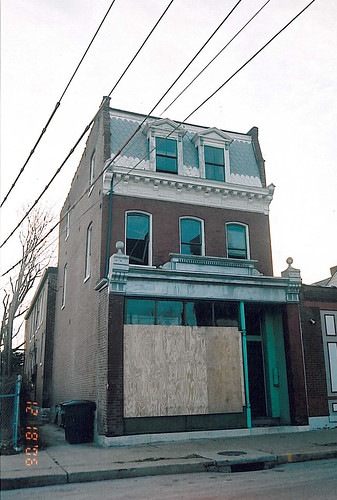 Read more about the Most Enhanced Sites here.
Read more about the Most Enhanced Sites here.
by Michael R. Allen
Tonight is the second night of the Chautauqua Art Lab, of which I am proud to be a part. Check out the details:
CHAUTAUQUA ART LAB
Map the multi-verse with controversial artists/speakers, pots and pans music makers, and film bricoleurs constellating for the temporary art and technology project co-organized by Eric Repice, Sarah Paulsen, and Emily Hemeyer. The series of nightly collaborative educational gatherings is inspired by the historical Chautauqua adult education movement in the US and features participatory panels, music soundscapes, and video screenings .
When: May 3-7th each night, 6:30 PM -10:00 PM
Where: Fort Gondo, 3151 Cherokee Street, St. Louis, MO, USA
Why: Learn, Include, Collaborate, Constellate (L.I.C.C.). “Chautauqua is the most American thing about America‖ Theodore Roosevelt
Monday, May 4: “Local Go-getters and How I Started My Space.†Public Forum Q & A with Matt Strauss (White Flag), BJ Vogt (MAPS), Juan William Chavez (Boots Contemporary), Nita Turnage and Hap Phillips (Artica), David Wolk (Cranky Yellow& Crammed Organisms), Stephen Brien (All Along Press), Firecracker Press, Open Lot, Luminary Center, and APOP.
Tuesday, May 5: “Personal and Collective Practices that Investigate Notions of Space, History, and Public Goods.†Demonstrations and discussion highlighting mapping, tagging, blogging, virtual studios, and YouTube as art spaces. Featuring Eric and Michelle DeLair Repice (Wash U), Michael Allen (Ecology of Absence), Ben West (WASABINET), Jordan Hicks (Open Lot), live animation by Sarah Paulsen and music by Macro Meltdown
Wednesday, May 6 : “Artist Viewpoints: Innovations and Boundaries in Community Art Practice.†Works and commentary by Cindy Tower, Lyndsey Scott, Keith Bucholdz, Peat Wollager, and Maya Escobar.
Thursday, May 7:“Exploratory Film Night:Time based art/video shorts exploring the use of found/appropriated images, collage and archives.†Including films by Jodie Mack (Chicago) Yard Work is Hard Work, Ken Brown and Tom Bussmann (Germany and Stl) Beyond the Crisis in Art, Emily Foster (San Francisco) Snowfakes, Mike Pagano (Stl), Jeremy Kannappell (Stl), Emily Hemeyer and more. Music by Kevin Butterfield. Opening Music, Flowers. All donated proceeds benefit CAMP (Community Arts and Media Project).
Contact : Press- Emily Hemeyer ghostsihavebeen@gmail.com
Sarah Paulsen pintorasp@hotmail.com
Eric Repice erepice@gmail.com
by Michael R. Allen
Residents of the Georgian Condominiums at City Hospital report that Koman Properties unveiled plans for the new Walgreens on Lafayette Avenuye last Thursday night at the residents’ meeting. The store will come up to sidewalk on Lafayette, with a corner entrance at the northeast leading both to the street and a parking lot to the east. The front of the building will be designed to appear as a two-story Georgian Revival commercial building. Walgreens won’t release plans for “unique” stores like this one, so we don’t have any images of the store.
The store’s parking lot will connect to an access road leading eastward to 14th Street. There are no immediate plans to build out the rest of the proposed retail development on Bohemian Hill. While the Walgreens will be fairly urban, Gilded Age says that they can find no grocery store willing to locate in a store built up to the sidewalk line on Lafayette. The developers should keep looking and wait for the credit crisis to diminish — there are plenty of chains, including Whole Foods and Trader Joe’s, that have built urban stores without parking in front. If Walgreens can do it, so can others.
The Bohemian Hill retail development remains a great case for a form-based zoning code. There would be no doubt that the site plan would be appropriate for the location if the zoning mandated urban placement. Retailers wouldn’t be able to drive a hard bargain for parking in front if they were constrained by zoning laws.
by Michael R. Allen
 In recent weeks, the four-family at 1714 S. 13th Street on Bohemian Hill has received a lot of rehab work. Krystal Group LLC purchased the building in November 2008. While I am no fan of the single-pane windows the investors installed in place of one-over-one windows that had been there, I am glad to see rehab work on Bohemian Hill.
In recent weeks, the four-family at 1714 S. 13th Street on Bohemian Hill has received a lot of rehab work. Krystal Group LLC purchased the building in November 2008. While I am no fan of the single-pane windows the investors installed in place of one-over-one windows that had been there, I am glad to see rehab work on Bohemian Hill.
The remaining houses on Bohemian Hill have been under threat of eminent domain for the past three years, and the Land Clearance for Redevelopment Authority had started buying houses on this block in 2007. Gilded Age Development is building a retail project named “Georgian Square” to the west on cleared land, and had originally discussed acquisition of the two blocks east of 13th Street. Those plans now are scuttled.
Meanwhile, Georgian Square is now under construction. At least, the Walgreens store is under construction on Lafayette Avenue across the street from City Hospital.
by Michael R. Allen
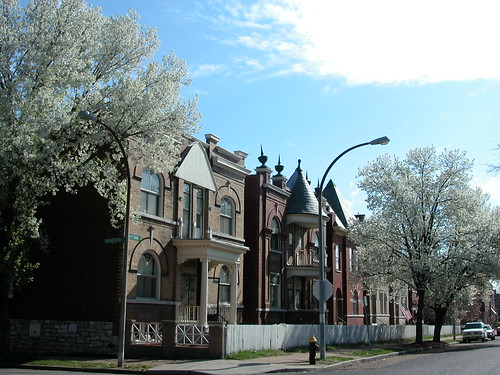 The flowering of Bradford pear trees on Wyoming Street is a good opportunity to showcase the cool, strange buildings at the northeast corner of Wyoming and Minnesota in Benton Park West. These two four-family buildings were built in 1896 by one D. Steimke for the cost of $3,700. A lot of construction was underway in Benton Park West at the time, although the July 1903 Sanborn fire insurance map page that includes this block shows more vacant than built-upon lots in the vicinity.
The flowering of Bradford pear trees on Wyoming Street is a good opportunity to showcase the cool, strange buildings at the northeast corner of Wyoming and Minnesota in Benton Park West. These two four-family buildings were built in 1896 by one D. Steimke for the cost of $3,700. A lot of construction was underway in Benton Park West at the time, although the July 1903 Sanborn fire insurance map page that includes this block shows more vacant than built-upon lots in the vicinity.
Now the area is one of the city’s most densely built-out and populated areas with a racial diversity unmatched in the city. The blocks upon blocks of brick buildings, the prevalent pedestrians of all walks of life, the playing children, the street trees — this adds up to city life at its best. Back in 1896, this big picture was still a handful of pieces, and the flats at 3023-25 and 3029-31 Wyoming were among the most unique pieces. They still are.
These regal buildings are twins in plan, mass, fenestration pattern and setback. The differences show a colorful architectural imagination at work. The corner building takes the plan and emphasizes horizontal lines with stone belt courses, flattened segmental arches and a dentillated cornice underneath a shaped parapet. A front porch forms a balcony. The windows on the front elevation probably have no twin anywhere else in the entire city.
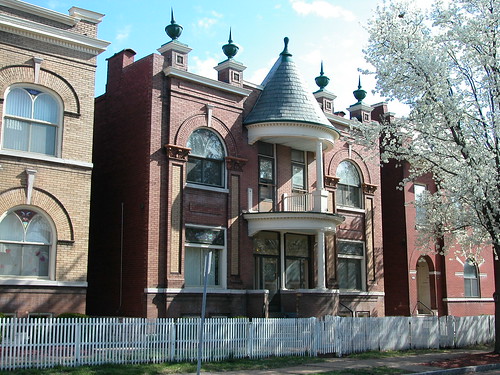 The inner building takes the plan and goes upward with verticality noted in each gesture. False pilasters with inset bricks of a different color rise up to robust Roman arches on the second floor windows. The shaped parapet forms bases for four urns topped by heavenward-directed finials. Here the center porch repeats the Roman arch shape in its curve and rises to form a tower that terminates in a conical turret. For the porch assembly alone, this house earns its rank as one of south city’s most unique.
The inner building takes the plan and goes upward with verticality noted in each gesture. False pilasters with inset bricks of a different color rise up to robust Roman arches on the second floor windows. The shaped parapet forms bases for four urns topped by heavenward-directed finials. Here the center porch repeats the Roman arch shape in its curve and rises to form a tower that terminates in a conical turret. For the porch assembly alone, this house earns its rank as one of south city’s most unique.
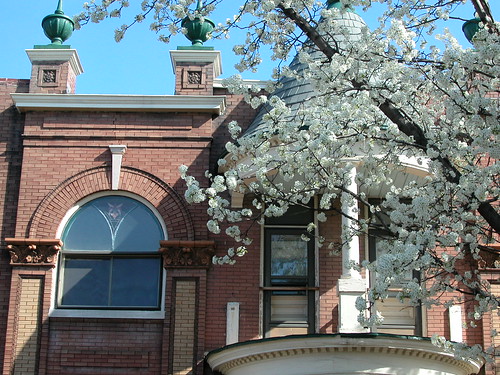
These two homes are fine illustrations of the late 19th century drive to experimentation in St. Louis residential architecture. Their eclectic classical revival style shows a wide range of influences and forms greatly enabled by the use of varied masonry units. Throughout the city, builders, draftsmen and architects of the period were crafting a turn-of-the-century sensibility truly unique to the city.
by Michael R. Allen
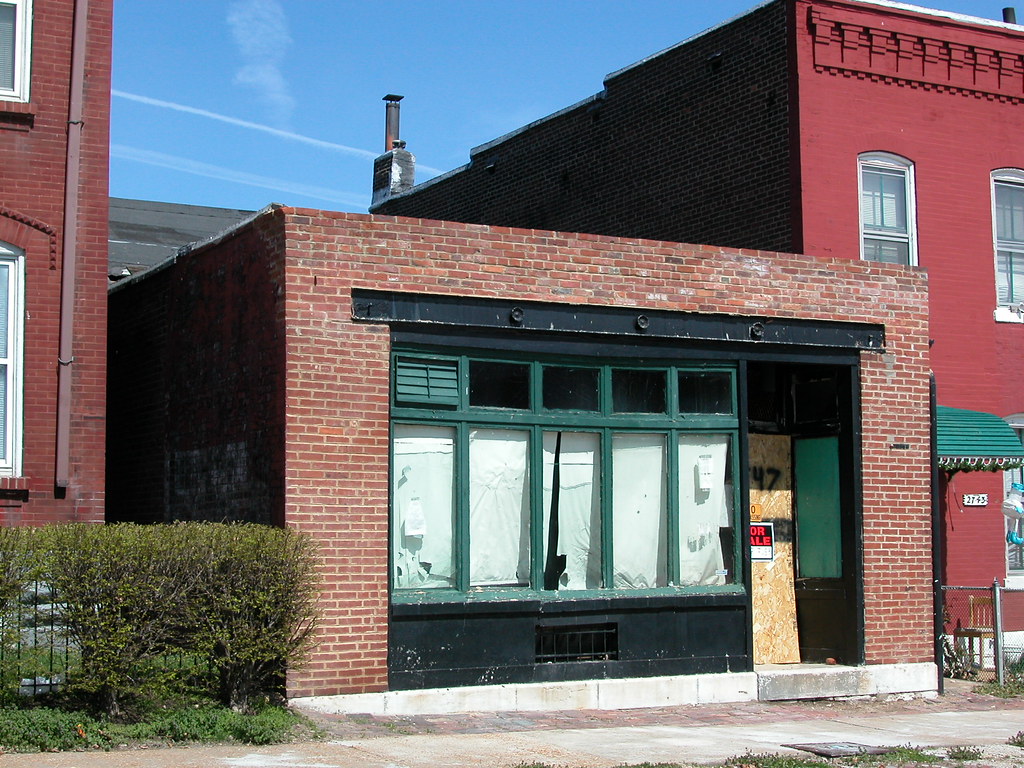 The storefront at 3747 Arsenal Street in Benton Park West is an addition to a small, two-room side-gabled brick house built in 1880. The 1903 Sanborn fire insurance map shows the storefront addition marked “plumber.” The storefront here is free of major changes, with its glazing in a historic (although not likely to be original) configuration. The building is now for sale.
The storefront at 3747 Arsenal Street in Benton Park West is an addition to a small, two-room side-gabled brick house built in 1880. The 1903 Sanborn fire insurance map shows the storefront addition marked “plumber.” The storefront here is free of major changes, with its glazing in a historic (although not likely to be original) configuration. The building is now for sale.
If you haven’t seen it yet, last week’s South City Journal feature “Saving a sense of the city” offers an overview of endangered south city buildings, ranging from the Avalon Theater to the smokestack at the Carondelet Coke plant. Sean Clubb assembled the story and Erica Burrus photographed the sites.
by Michael R. Allen
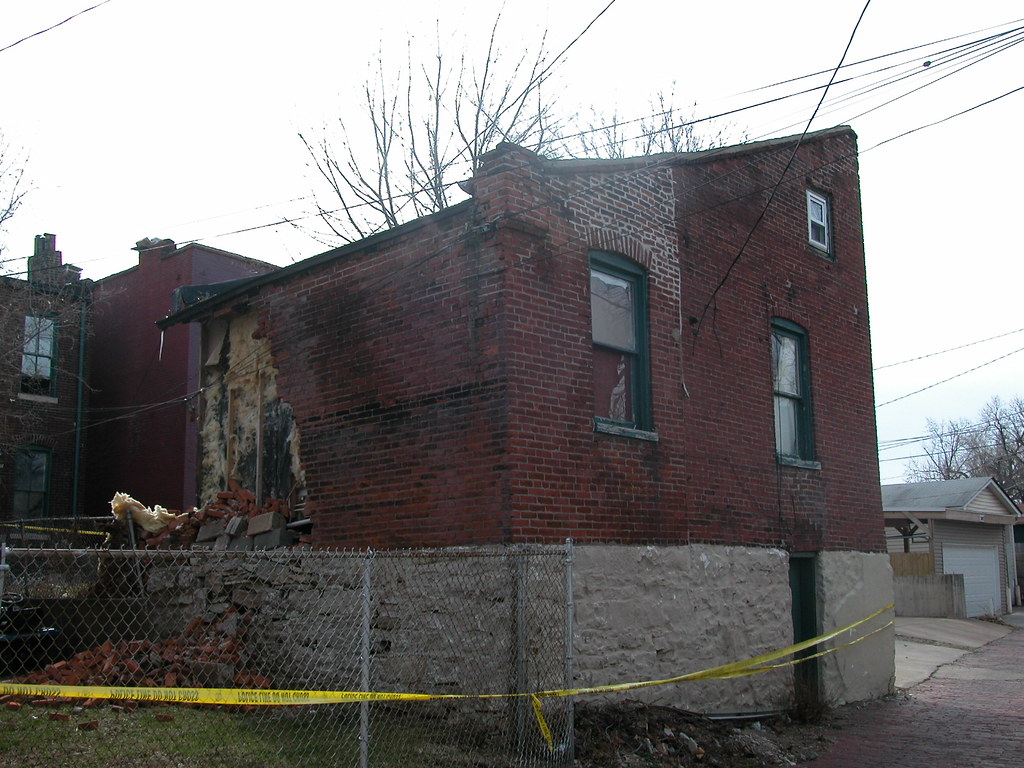 Earlier this month, the flounder house at 2809 McNair (Rear) in Benton Park endured a collapse of part of one of its side walls as well as part of a its front (east) wall. The damage is severe, but the condition is not beyond the reach of some temporary telescoping jacks. In fact, the side wall that bears the roof weight is studded out, so there is a wall in place holding that weight for now. Of course, that wall is made of new soft pine and is not a long-term guarantee of survival. The building needs the corner relayed. No big deal!
Earlier this month, the flounder house at 2809 McNair (Rear) in Benton Park endured a collapse of part of one of its side walls as well as part of a its front (east) wall. The damage is severe, but the condition is not beyond the reach of some temporary telescoping jacks. In fact, the side wall that bears the roof weight is studded out, so there is a wall in place holding that weight for now. Of course, that wall is made of new soft pine and is not a long-term guarantee of survival. The building needs the corner relayed. No big deal!
As the photograph shows, the flounder consists of an original one-and-a-half story section and an addition at the low end of the roof. Building permits date the original house to 1884, and the addition to before 1900. the house has been vacant for the past five years, with some deterioration and structural problems.
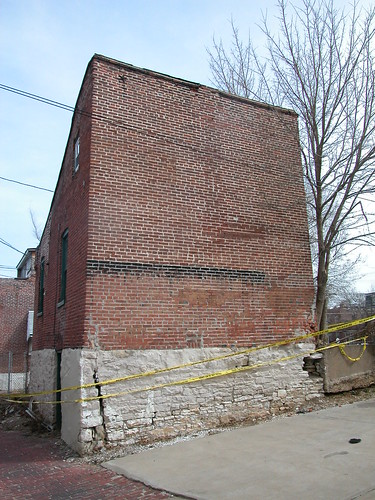 The south side of the buidling has prominent stress cracks, but shows no imminent danger. If the owner doesn’t have fund to repair the collapse, he could remove the addition and restore the original flounder house, which probably had a gallery porch in the spot wher ethe addition now stands. There are always so many solutions that are not total demolition. Will our Buidling Division urge one of these other solutions this time?
The south side of the buidling has prominent stress cracks, but shows no imminent danger. If the owner doesn’t have fund to repair the collapse, he could remove the addition and restore the original flounder house, which probably had a gallery porch in the spot wher ethe addition now stands. There are always so many solutions that are not total demolition. Will our Buidling Division urge one of these other solutions this time?
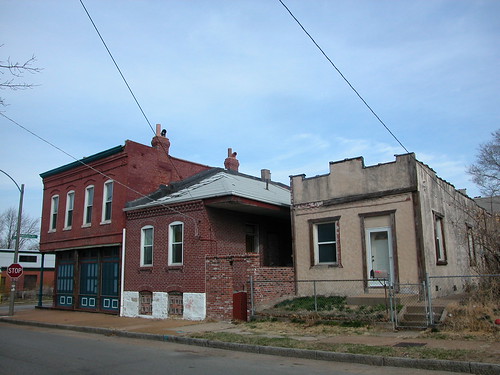 A short walk down the alley and back onto Lynch Street, one finds an intact and lived-in flounder house. This flounder has a front-hipped roof instead of the severe side slope seen on others. The group of buildings in which it plays a part is a great example of how diverse forms, styles, materials and setbacks can create a unique urban street face.
A short walk down the alley and back onto Lynch Street, one finds an intact and lived-in flounder house. This flounder has a front-hipped roof instead of the severe side slope seen on others. The group of buildings in which it plays a part is a great example of how diverse forms, styles, materials and setbacks can create a unique urban street face.
